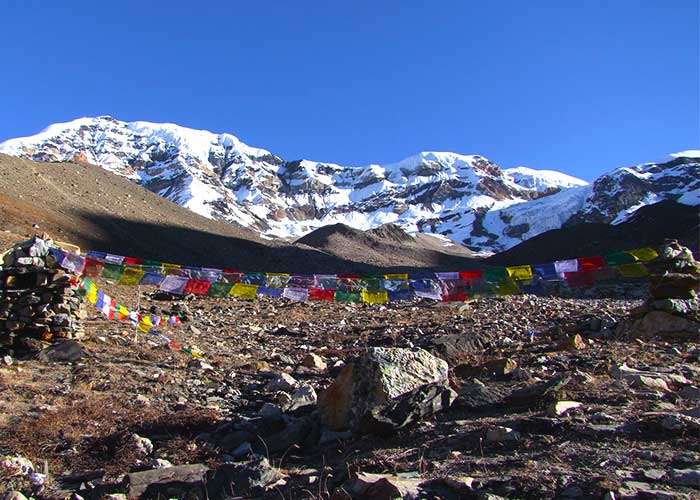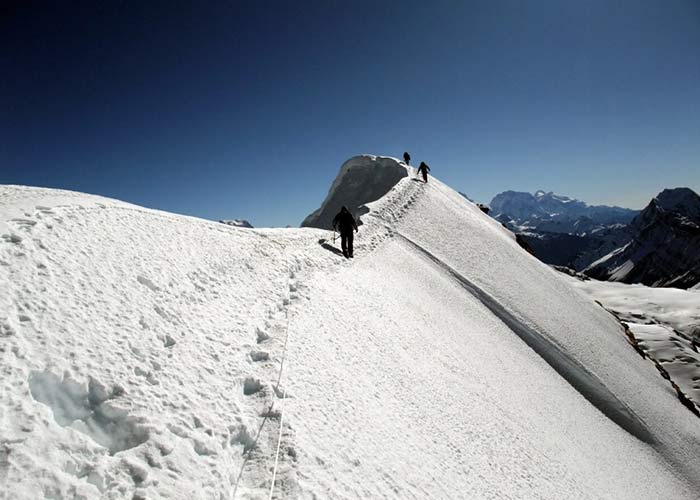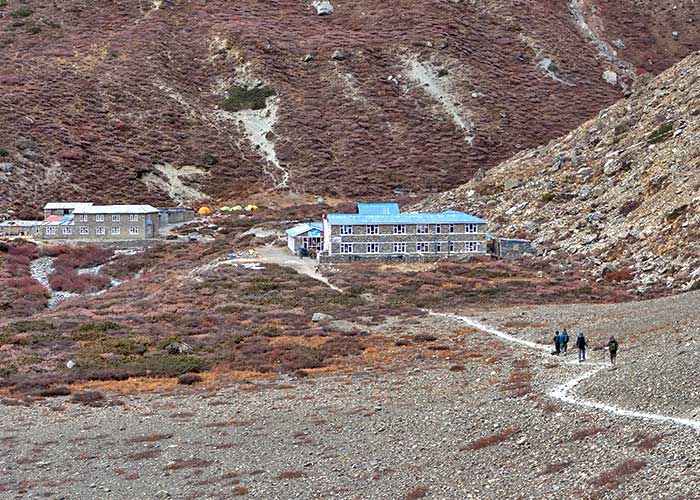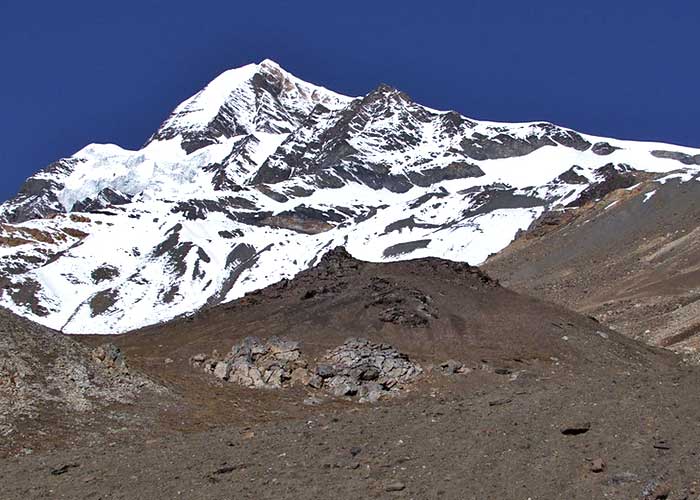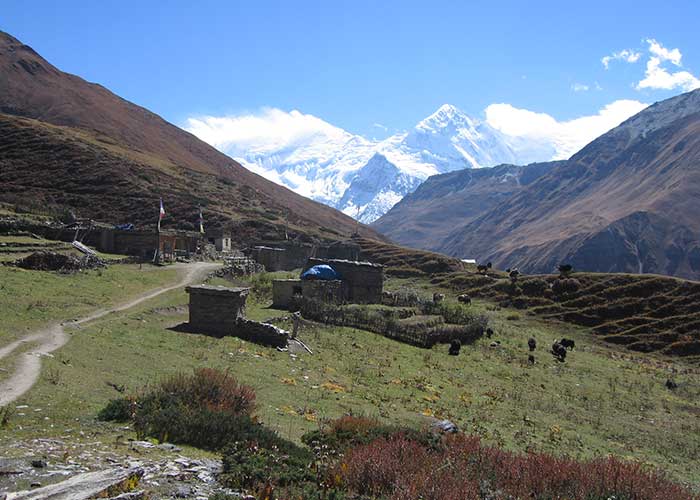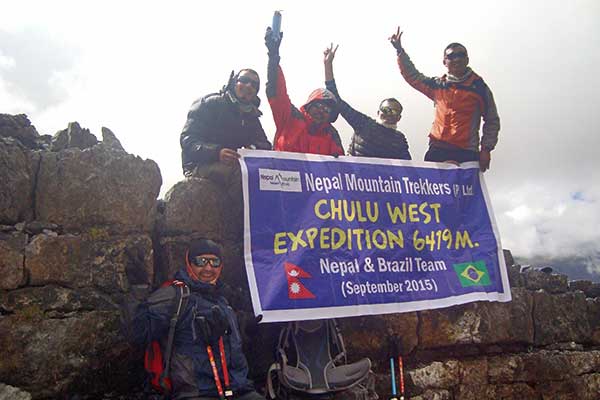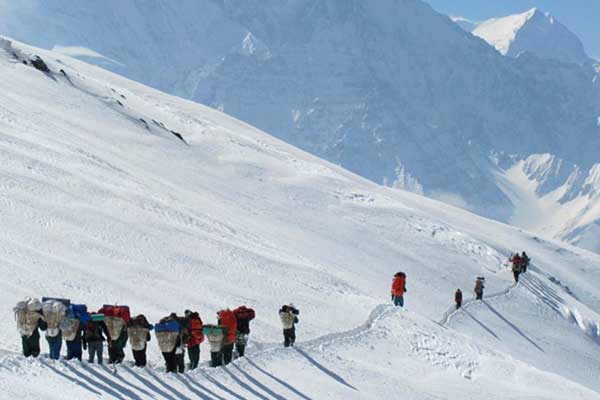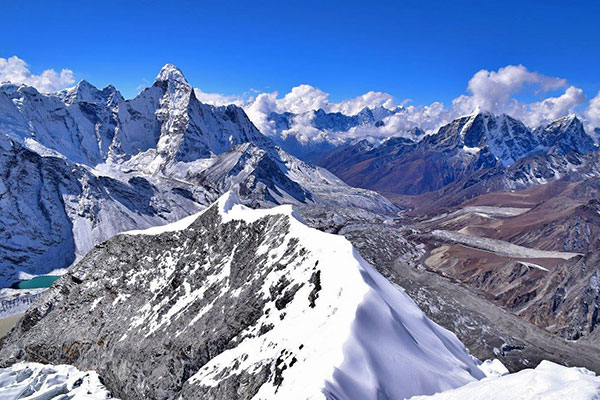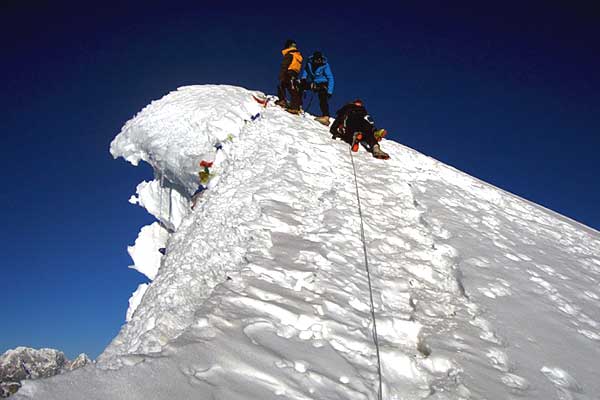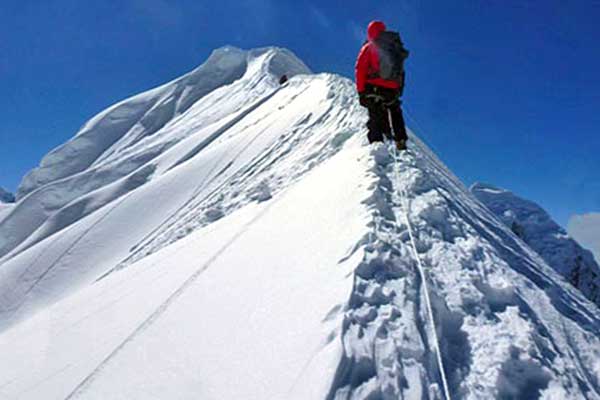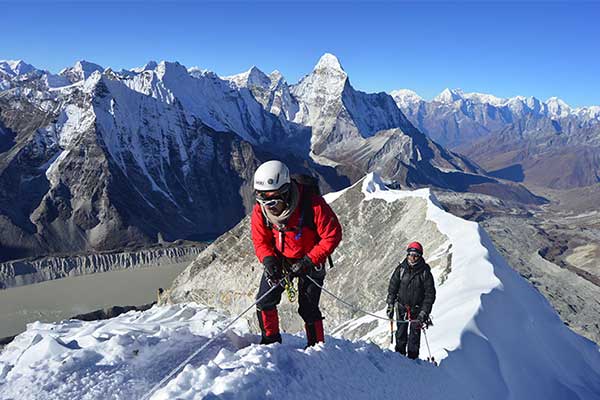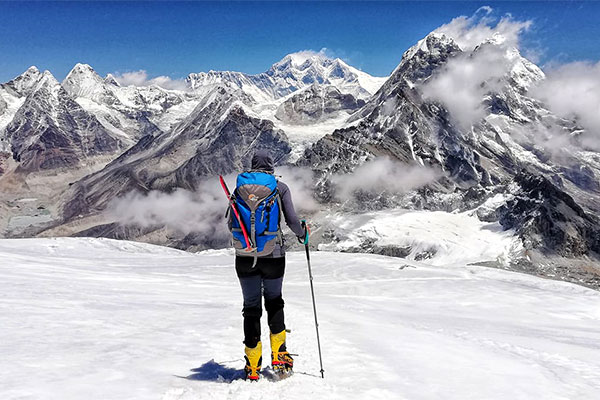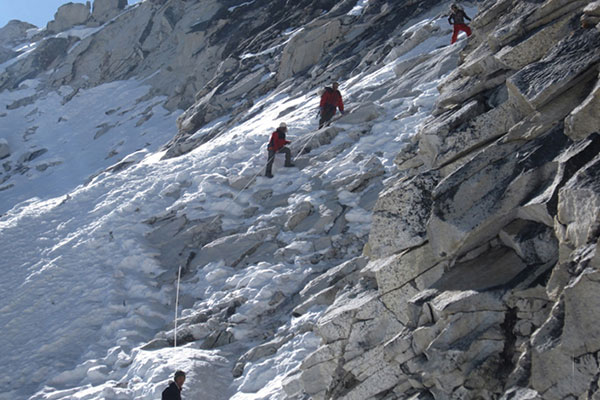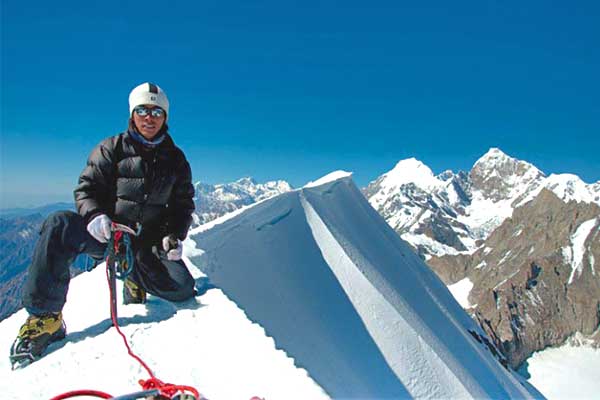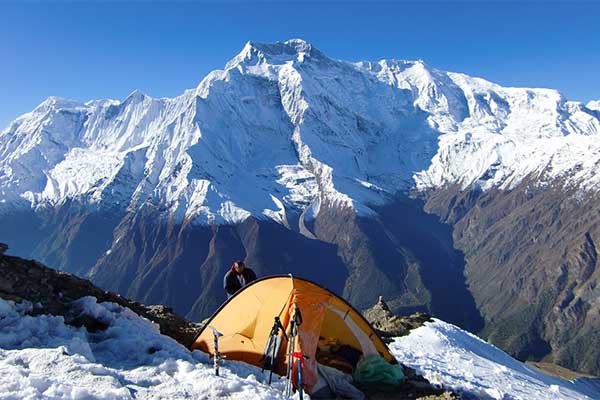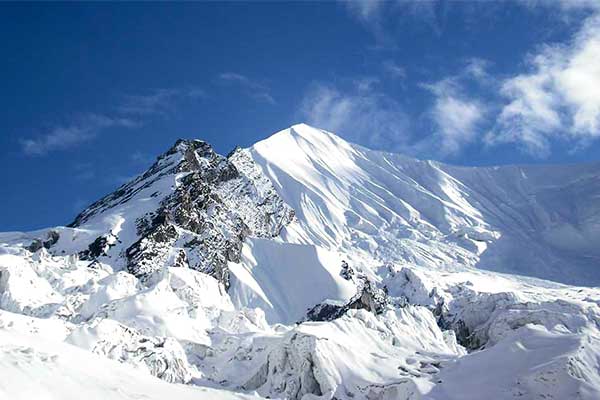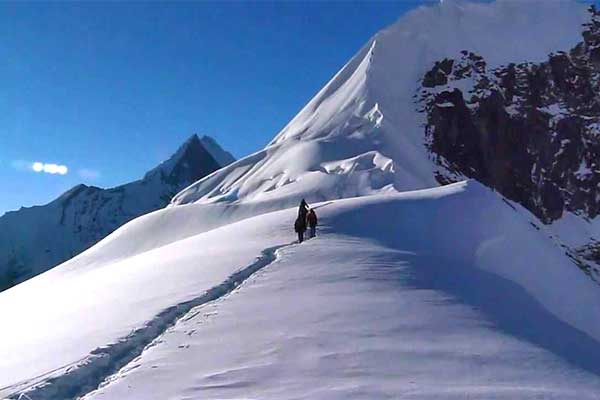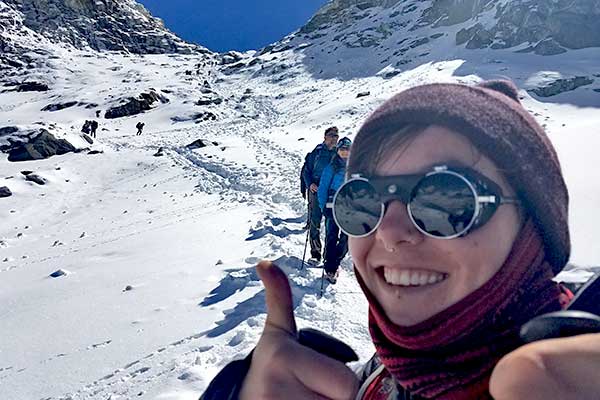Overview
Duration :
22 Days
Secondary Activity:
Nature and Glacier Walk
Max altitude :
6,059m/19,878 ft
Transportation:
Domestic Flight and Private Vehicles
Trip ends in:
Kathmandu
Accomodation:
Lodge and Tent Camp
Primary activity:
Trekking and Hiking
Group Size:
Min. 2 pax
Country:
Nepal
Trip starts from:
Kathmandu
Diffficulty:
Strenuous Plus
Meals:
Nepali and Continental
Best Season:
Autumn and Spring
Trip route:
Kathmandu-Jagat-Dharapani-Chame-Pisang-Humde-Julu Khola-Chulu Far East Base Camp-Manang-Siri Kharka-Mesokanta-Jomsom-Pokhara-Kathmandu
Trip introduction
“We need the tonic of wilderness. We can never have enough of nature.”
– Henry David Thoreau
Chulu Far East Peak Climbing is a comparatively moderate peak-climbing adventure passing through the tranquil landscapes and traditional cultural heritage dominated by Gurung people in the Annapurna region. The trek will take you by way of the amazing backdrop and let you view distinctive culture. We traverse pine, and rhododendron forests, the terraced meadows, the Gurung community, and the warm nature of Manang inhabitants. It is located high over the Manang Valley offering the wonderful vistas of mountain ranges. Which includes Annapurna II, III, IV, Glacier Dome, Dhaulagiri, Gangapurna, Tilicho as well as Manaslu peaks.
Chulu Far East Expedition kicks off from Jagat and goes up to the Marshyangdi valley. And traverse the well-known Throng-La pass (5416M) and then trek down to the Kali Gandaki valley to reach Pokhara. Nepal Mountaineering Association(NMA) classifies the peak as Trekking Peak category B. Chulu Far East Peak Climbing has been compared in character to Island Peak in the Everest region and offers some really interesting climbing without being too technical. Using a high camp, we make our ascent via straightforward snow-slopes to a sensational pinnacle summit.
The Chulu Far East Peak climbing is technically undemanding and all you need to be familiar with is –using equipment like- crampons, ice axe, harnesses, tying knots, and managing climbing ropes. Together with peak climbing, the trip also encompasses the world’s highest Tilicho Lake (4,949m) which holds a special position among the Hindu followers.
Chulu Far East Peak Climbing is one of the best treks offering a distinct sensation. In general, the best time for this trek would be Sep-Oct-Nov and Mar-Apr-May. So join Nepal Mountain Trekkers for this trek to experience great Nepalese natural diversity.
Special Note:
If this itinerary doesn’t suit your requirement or if you want to customize it, please feel free to contact us. This trek could be customized as per your required time frame and budget limits.
Overview
-
Day 1Arrival at Kathmandu. (1,350m/4,428ft):
-
Day 2Kathmandu Sightseeing and Preparation for the Climbing:
-
Day 3Kathmandu to Jagat by Bus (1,300m/4,265 ft):8-9 hrs (By Private Jeep):
-
Day 4Jagat to Dharapani (1,950m/6,396ft): 6-7 hrs:
-
Day 5Dharapani to Chame (2,630m/8,628ft): 5-6 hrs:
-
Day 6Chame to Pisang (3,200m/10,498 ft):5-6hr:
-
Day 7Pisang to Humde Village (3,330m/10,925 ft): 3 – 4 hrs:
-
Day 8Humde to Julu Khola (3,500m/11,482 ft): 3 – 4 hrs:
-
Day 9Acclimatization Day at Julu Khola:
-
Day 10Julu Khola to Chulu Far East Base Camp (5,000m/16,404 ft): 5 – 6 hrs:
-
Day 11Acclimatization Day at Chulu Far East Base Camp:
-
Day 12Base Camp to Chulu Far East High Camp (5,500m/18,044 ft): 3 – 4 hrs:
-
Day 13High Camp to Chulu Far East Peak (6,059m/19,878 ft) to Base Camp: 8 – 9 hrs:
-
Day 14Chulu Far East Base Camp to Manang (3,550m/11,646 ft): 5-6 hrs:
-
Day 15Manang to Siri Kharka (4,060m/13,320 ft): 4 – 5 hrs:
-
Day 16Siri Kharka to Tilicho Base Camp (4,140m/13582 ft): 5 – 6 hrs:
-
Day 17Tilicho Base Camp to Tilicho Lake (4,949m/16,236 ft): 3-4 hrs:
-
Day 18Tilicho Lake to Mesokanta La Pass to Yak Kharka (4,200m/13779 ft): 7 – 8 hrs:
-
Day 19Yak kharka to Jomsom (2,743m/9,000 ft): 5 – 6 hrs:
-
Day 20Jomsom to Pokhara (820m/2,960): 25 minutes by flight:
-
Day 21Fly/Drive to Kathmandu (By Bus 5-6 hrs and By Flight 35minutes):
-
Day 22Departure Day:
Detail Itinerary
Day 1 : Arrival at Kathmandu. (1,350m/4,428ft)::
Upon your landing at Tribhuwan International Airport (TIA) in Kathmandu, a representative of Nepal Mountain Trekkers shall be waiting for you at the airport terminal to welcome and greet you. Later in the evening, you may walk around in the lanes of Thamel or Stay in your hotel room which relies on your condition of choice. Appreciate the authentic culinary and experience warm cordiality at the lodging that should acquaint you with the wealth of Nepalese sustenance culture. Stay overnight in Kathmandu.
Day 2 : Kathmandu Sightseeing and Preparation for the Climbing::
In a day prior to moving to the trekking, today we should prepare all the trekking and climbing necessities including climbing license, ACAP permit, and others. Check whether every one of the types of gear required amid the trek and climbing is prepared and in immaculate condition. Go shopping in the event that you discover any riggings and types of gear missing. We might have a pre-trek meeting where you should be informed about the trekking and moving to the Chulu Far East Peak. Accept this open door to illuminate you about any inquiries identified with the trekking and climbing. Alternatively, you may likewise have the touring and exploration around the Kathmandu valley including the chronicled regal castles, sanctuaries, religious communities and stupas, old statues, and different sites of verifiable significance. Stay overnight in Kathmandu.
Day 3 : Kathmandu to Jagat by Bus (1,300m/4,265 ft):8-9 hrs (By Private Jeep)::
We start our campaign today with the drive to Jagat, the beginning stage of our trekking and climbing. We begin early today as the excursion today might be a long one as we are to go 130 km west of Kathmandu valley. The street till Besisahar is a genuinely decent street that is coal-tarred while the street after that is dusty and uneven which may represent some inconvenience to the explorers. Notwithstanding, the length of the trip might pass away easily as you should have the chance to witness country Nepal amid the drive. Lavish and green slopes and valleys, exuberant and quick streaming waterways, towns with the conventional way of life genuinely undisturbed by present-day improvements, terraced cultivating, and charming perspective of the wonderful snow-topped mountains on the way should be the highlight of today’s voyage. Stoppages amid the drive should furnish you with the opportunity to cooperate with the inviting local people. Stay overnight at Jagat.
Day 4 : Jagat to Dharapani (1,950m/6,396ft): 6-7 hrs::
In the trekking today we should meet the neighborhood occupants who have relocated from Tibet a long time prior and go into the secretive yet charming Mustang area. Proceed with the trek ahead along the lofty trail and desert the wonderful perspective of the stream beneath the town and the alluring waterfall over the waterway. Trek along the trail and go through the settlements of Chamje, Ghatte Kholagaon, Chamje, and Sattale, have the perspective of rich valleys and slopes, coexist with long hot climb and development fields to reach Tal town after which we enter Mustang locale. In front of Tal, the trail rises to soak for quite a while, takes a plunge, and rises again on the high slopes to take us to Dharapani. Marshyangdi River proceeds with its thunder while we trek past the Mani dividers, cross some suspension extensions and navigate through littler settlements as we reach Dharapani. Other than communicating with the Tibetans and Gurung people group at Tal town, you should likewise encounter the uniqueness of their way of life. Stay overnight at Dharapani.
Day 5 : Dharapani to Chame (2,630m/8,628ft): 5-6 hrs::
Today we might leave Dharapani, one of the greatest towns in the Manang area, and move to assist profoundly into the locale. The trek today has for the most part trips as we are gradually moving to higher elevations. From Dharapani, the trail goes through schools and makes the climb to a slope and afterward plunges to Bagarchhap inside an hour of trekking. Encounter the Tibetan culture in this town which has cloister, gompa enhanced with supplication haggles reflecting Buddhist culture. Pushing forward through the restricted forested crevasse and past the perspective of the waterfall, we reach another Tibetan town of Danakyu. Continuing ahead, we might now go into the locale with thick backwoods, cross little tributaries, trek past waterfall and stroll over soak stones and navigate through a couple of Tibetan settlements, for example, Thanchow and Koto to reach the goal, for now, Chame. Chame is likewise the regulatory central command of the Manang area. In transit, you can have an awe-inspiring perspective of mountains, for example, Annapurna II and some different peaks in the Annapurna range. Stay overnight at Chame.
Day 6 : Chame to Pisang (3,200m/10,498 ft):5-6hr::
We leave Chame in a trail with suspension signal decorated by petition banners and trail with stone strides and in a lofty thin trail through thick woodland, you reach the bent shake confront which lies high over the stream. From this detect the landscape you witness is simply past portrayal. In a trail that has a few good and bad times, you navigate through the settlement of Talkeu following 40 minutes and afterward to settlement possessed by Khampang people group generally, the town of Bartang. In front of this conventional limit between the Manang zone toward the north and the Gurung region toward the south, trekkers may take after the trail joined by River and climb to Manang valley and Lower Pisang in the wake of intersection a waterway or they may go up against the trail to Upper Pisang which is grander. The decision is made by the trek pioneer amid the trek. You can encounter a change in scene and vegetation, where the territory turns out to be more bone-dry and vegetation sparser and staggering Rockwall ignores the trail. Stay overnight at Pisang.
Day 7 : Pisang to Humde Village (3,330m/10,925 ft): 3 – 4 hrs::
After waking up we shall have our breakfast at the usual time and later on continue forward with our trek towards another destination. This part of the excursion today shall go through the mountain trail and towards the end, we shall arrive at Humde – a little town situated at an elevated height of 3,330 meters above sea level. This place falls on the path where you can discover the Manang airstrip, a few houses, and cabins. Subsequent to coming to his little settlement, you can watch one of the longest supplication wheels in the area. Stay overnight at Humde.
Day 8 : Humde to Julu Khola (3,500m/11,482 ft): 3 – 4 hrs::
Our goal for today is Julu Khola which takes us to an elevation of 3,500 meters above sea level. After having our breakfast, we shall as usual start moving away from Humde and begin going through the marginally forested ways that are bound to bring you to Julu Khola. In the middle of the trek, you can catch the sublime perspectives of Annapurna Valley Himalayas alongside the looks of the Pisang pinnacle. Stay overnight at Julu Khola.
Day 9 : Acclimatization Day at Julu Khola::
As we are trekking to higher elevations, it is quite necessary to keep in mind that the situation above this altitude is very harsh for our bodies. So to keep moving forward with our trek, we have prepared a full day entirely for acclimatization purposes. This day can be easily marked as one of the significant days of our trek as this day helps your body to get acclimatized/adjusted to the surrounding environment. During the time spent, today you will stroll along the Julu Khola and get the charming perspectives of the Annapurna Himalayas including the scene of Pisang Peak. Stay overnight at Julu Khola.
Day 10 : Julu Khola to Chulu Far East Base Camp (5,000m/16,404 ft): 5 – 6 hrs::
Today we shall continue moving forward and proceed further to Chulu Far East Base Camp. Strolling through the steeply climbing trail today brings you to the base camp of Chulu Far East Peak. In spite of the fact that the trail goes through rocks on occasion, the unrivaled perspectives of Annapurna Valley Himalayas on the course let you encounter the genuine delight of trekking in Nepal. Stay overnight at Chulu Far East Base Camp.
Day 11 : Acclimatization Day at Chulu Far East Base Camp::
It is day 11 of our adventurous journey and it is formally planned as a day for rest or in other words it is acclimatization day which is very vital to let your bodies adjust to the surrounding environment at these kinds of high altitudes. This place is perfect for taking a time out and gives our bodies time to get acclimatized properly which will surely help trekkers/climbers to continue with their trek to more high altitudes. As we need to climb to higher elevations while summiting the peak, we shall meander around the local area and observe the local way of life or take a short climb amid the day. We will likewise plan for the climb and architect our climbing gears. Stay overnight at Chulu Far East Base Camp.
Day 12 : Base Camp to Chulu Far East High Camp (5,500m/18,044 ft): 3 – 4 hrs::
Get ready for another adventurous day as this day of the segment of the outing from the base camp again takes after a steeply climbing trail through the snow inclines. The mountain travel today offers you the amazing vistas of Annapurna Valley Himalayas, Chulu East, Chulu West, Pisang Peak, and the Chulu Far East. While going through getting a charge out of the all-encompassing vistas of a chain of mountains in the district, the trek, in the end, lands at the sight of the high camp of the Chulu Far East pinnacle. Stay overnight at High Camp.
Day 13 : High Camp to Chulu Far East Peak (6,059m/19,878 ft) to Base Camp: 8 – 9 hrs::
The pinnacle climbing trip today conveys us to the wonderful purpose of this enterprise in the Himalayas as we overcome the highest point of Chulu Far East. Henceforth, today we will start the peak climbing trip around 2 – 3 AM in the morning. At the beginning of our trek, we shall take after a level trail. The following area of the trail continuously gets to be distinctly more extreme and even crosses shake in the mountain tracks. The appealed trek, in the long run, puts across to the point of peak of this segment of the excursion that is the highest point of Chulu Far East. From the highest point of the pinnacle, we can appreciate the inconceivable perspectives of Annapurna II, III, IV, Gangapurna, Manaslu, Pisang Peak, Chulu west, and the Himlung Valley at the north side. In the wake of catching the spellbinding perspectives from the highest point of the pinnacle, we will plummet up and down the vertical slants to the high camp at first and afterward again take after a slipping trail to reach the base camp of Chulu Far East. Stay overnight at Base Camp.
Day 14 : Chulu Far East Base Camp to Manang (3,550m/11,646 ft): 5-6 hrs::
Carrying on with our trek, we shall now move in line towards the Manang village as planned in our itinerary. Today as we trek forward, in the beginning, we shall cross the descending trails of the trek which will lead us up-to Julu Khola. The following segment of our trek also goes through a level/plain trail along the backwoods to bring you to Manang which is a Trans-Himalayan town just beneath the Thorong La Pass and a place where we shall remain the following night. Manang is considered a lovely town situated at an elevated height of 3,550 meters above sea level with typically involved settlements of indigenous Gurung, Ghale, and Lama. Stay overnight at Manang.
Day 15 : Manang to Siri Kharka (4,060m/13,320 ft): 4 – 5 hrs::
Waking up with great joy, we shall now head onward with our trek. After having our breakfast, we carry our bags and then make a way through down by the waterway. Later on, we complete a path filled with timberlands of coniferous which in turn shall bring you to Khangsar town. This place is 4,120 m above sea level and looks like a ghost’s village, because of the fact that there are numerous houses but you don’t see a lot of people living here. The anticipated trekking trail out from the town gives trekkers a magnificent view of Gungang Himal and Mt. Chulu. In the wake of the intersection of the religious community and the consistent trail ahead, in the long run, shall take you to Siri Kharka which shall be our final destination for this day. Stay overnight at Siri Kharka.
Day 16 : Siri Kharka to Tilicho Base Camp (4,140m/13582 ft): 5 – 6 hrs::
From Siri Kharka we should now head towards the Tilicho Base Camp so today our trail will, for the most part, be downhill with extremely limiting trails in its course today even going through the unsafe avalanche zones of the area. The persistent trek over the thin trail getting a charge out of the sights of noteworthy shake development at long last rests at the base camp of Tilicho Lake. Stay overnight at Tilicho Base Camp.
Day 17 : Tilicho Base Camp to Tilicho Lake (4,949m/16,236 ft): 3-4 hrs::
Today you will reach another vital goal of this mountain enterprise and it is Tilicho Lake which holds a particular position among Hindu supporters around the globe. The climbing trail today along the moraine edges and verdant inclines brings you to Tilicho Lake which is settled at the foot of the north face of Tilicho Peak. Gloating as the most astounding elevation lake on the planet, it has a ruling position in Ramaya – one of the sacred writings of Hindus. The lake gathers the cold soften of the Mt Annapurna and Thorong-La Pass. Stay overnight at Tilicho Lake.
Day 18 : Tilicho Lake to Mesokanta La Pass to Yak Kharka (4,200m/13779 ft): 7 – 8 hrs::
In the wake of investigating the lake and its encompassing perspectives, you will take after a climbing trail to touch base at Eastern Pass (5,340m) from where we can appreciate the charming perspectives of Annapurna, Gangapurna, and Tilicho Himal. At that point, we will go through a slipping trail at first till to Mesokanta La Pass (5,121m) at where we can appreciate the breathtaking perspectives of Dhaulagiri, Nilgiri, Tilicho Himal, and Tukuche Peak. Keeping the hypnotizing perspectives of a chain of Himalayas, we will again proceed with the sliding trail at some separation. The finish of the slipping trail makes ready forward a level trail to associate us with Yak Kharka. Stay overnight at Yak Kharka.
Day 19 : Yak kharka to Jomsom (2,743m/9,000 ft): 5 – 6 hrs::
Today is another day as we descend further down to Jomsom from Yak Kharka. The plummeting trail today ahead at first brings us to Thinigaon. In the wake of an intersection through the town shall take you after a level trekking path which will in the end lead us to Jomsom along with the capturing perspectives of Mt. Dhaulagiri, Mt. Nilgiri, and Tukuche Peak. Extending over the banks of Kali Gandaki, Jomsom is sometimes considered as the New Fort which is positioned at a high altitude of about 2,700 m above sea level in Mustang District of western Nepal. Stay overnight at Jomsom.
Day 20 : Jomsom to Pokhara (820m/2,960): 25 minutes by flight::
The adventure in the captivating Annapurna district and the once limited regions of Manang and Mustang, we should leave for Pokhara. This denotes the finish of our daring trekking. The flight to Pokhara from Jomsom begins at a young hour in the day as toward the evening the climate makes unsettling influences for the flight to occur. Hovering over the differentiating scenes, over the most profound chasm and the lavish valley made by Kali Gandaki River, with the perspective of sparkling mountains including the Annapurna massifs we reach the beautiful city of Pokhara. Subsequent to unwinding we should move in for the outing around the Pokhara valley. Stay overnight at Pokhara.
Day 21 : Fly/Drive to Kathmandu (By Bus 5-6 hrs and By Flight 35minutes)::
This is the last day of this energizing enterprise as we make a beeline for Kathmandu from the lovely Pokhara valley. Beginning right on time from this picturesque city we cross through country towns and scenes, wandering aimlessly street, green slopes, little and lovely waterfalls, religious site, for example, Manakamana Temple, exuberant waterways, for example, Trishuli and Marshyangdi and in addition the perspective of the humongous mountains disregarding the trail from far away. Upon reaching Kathmandu you shall be transferred to your hotel room where you can loosen up your tired bodies. Stay overnight at Kathmandu.
Day 22 : Departure Day::
Today marks the end of our 22 days Chulu Far East Peak Climbing so a representative of Nepal Mountain Trekkers shall escort you to the Tribhuvan International Airport (TIA) in Kathmandu. We trust that you were able to make the most out of this experience and create incredible memories to last a lifetime. Lastly, we hope you have a safe flight back home!
Price Includes
- Airport Pick up and drop
- 3 nights Hotel in Kathmandu(Hotel Green Horizon or similar standard)
- All accommodation during the trek in the best hotels/tea houses in the area (differing according to the price you wish to spend)
- Sanitation: The accommodation we provide will be neat and clean with warm hospitality and quality services.
- Single Accommodation: You won’t have to share your accommodation with anyone else so your privacy is protected.
- All foods during the trek: Breakfast, Lunch, and Dinner; any items on the menu as much as you wish to consume.
- We provide hygienic and safe meals to re-energize you.
- We request you not to waste your meals for it is difficult to transport food in the rural area.
- You are not allowed to share your meals with anyone else from another group.
- All required camping equipment
- Domestic Flights and all required land transportation
- Professional and Highly experienced English-speaking Trekking Guide licensed by the Government. Including their lodging and food.
- Local Staff: Our guides are locals of the region which ensures that you will surely get to explore a bit more during the trek than with any other guides.
- Experienced: With the experience of more than a decade of working in this field, our trekking guides possess excellent knowledge of briefing during the trek as well as they are experts in handling all kinds of critical situations which might occur during the trek.
- Insurance: Nepal Mountain Trekkers have an insurance policy for all our trekking staff.
- Porters (1 porter for 2 trekkers with a max load of 25 KG). Including their lodging and food.
- Local Staff: The porters we hire belong to the same region where we trek in order to provide employment opportunities to the locals as well as to make you explore every prospect of the region.
- Well-experienced ice climbing guide (Climbing service charge, insurance, food, personal equipment)
- Group Climbing gear fixed rope, main rope, ice axe, zoomer, harness, the figure of eight, carabineer
- Four seasonal sleeping bags, down jacket, Nepal Mountain Trekkers duffer bag, t-shirt, and trekking map (Note: down jacket and sleeping bag are to be returned after trip completion)
- Peak Permit Royalty, Annapurna Conservation Area Entrance Fee
- Rescue Arrangement Service
- A comprehensive medical kit
- 13% VAT and 10% service charges
- Farewell Dinner
Price Excludes
- Nepalese visa fee (Visa Information)
- International airfare to and from Kathmandu
- Excess baggage charges
- Lunch and evening meals in Kathmandu and Pokhara
- Extra night accommodation(s)
- Travel Insurance and rescue cost
- Personal expenses (phone calls, laundry, bar bills, battery recharge, extra porters, bottle or boiled water, shower, etc.)
- Personal trekking and climbing gears
- Tips for guides and porters
Equipments
 Equipment List
Equipment List
- Duffel Bag
- Day Pack (35-45 L)
- Sleeping Bag (-20F/-30C recommended)
- Down Jacket
- Trekking Boots
- Crocs (evenings & washing)
- Trekking Pants (2-3)
- T-Shirts (3)
- Long-sleeve Trekking Shirts (2-3)
- Trekking Jacket
- Gortex (or similar) Jacket & Pants
- Fleece or Thermal Top (evenings)
- Fleece or Thermal Bottoms (evenings)
- Lightweight Long Underwear (to sleep in or layer under clothes)
- Socks (5)
- Gloves (lighter & heavier for passes)
- Wool Hat
- Baseball Cap or Wide-brimmed Hat
- Camp Towel
- Trekking Poles (optional, recommended)
- Down Booties (optional, recommended)
- Sunglasses (2)
- Water Bottles | Nalgenes (2-3)
- Bladder (optional, recommended)
- Toiletries, Sunscreen with SPF, Lip Balm with SPF
- Watch (with alarm)
- Extra Batteries
- Battery Chargers
- Head Lamp (2)
- Yak Trax (for treks with icy passes)
- Water Purifying Tablets, Small Water Filter or Steripen
- Camp Washing Bowl (optional, collapsible for clothes)
- Laundry Detergent (Kathmandu) or Bio-degradable Clothes Soap
- Hand Sanitizer
- Small Solar Panel (optional, recommended for iPods, iPhones, camera batteries, Kindles)
- Book(s)
- Zip-Lock | Plastic Bags
- Soft Toilet Paper | Tissues (we supply toilet paper but you will want something softer for blowing your nose)
- Baby-Wipes | Wet-Wipes (for personal cleaning)
- Handi-Wipes, J-Cloth, or Chux (optional: easy for a quick daytime clean, fast drying)
- Rehydration | Electrolytes
- Snacks!
- Personal Medical Supplies
- Available in Namche Bazaar
- Snacks, chocolate bars, energy bars (Western brands), dried fruit & nuts
- Laundry Detergent
- ALL trekking gear (Sherpa Gear, Mountain Hardwear, Tsetang’s Gear Shop all have real gear), real & knock-offs.
- Lemon Tang (for water if you want)
- Batteries
- Trekking Poles
- Micro Spikes
- Medical Supplies
- We strongly suggest bringing Western meds with you as there are a lot of Indian fakes on the market!
- Suggested: Diamox, Azithromycin, Ciprofloxacin, Tinidazole, or Flagyl & Augmentin. Bring COMPEED for covering blisters & good tasting electrolytes &/or rehydration salts (Emergen-C is a good American brand). The local versions aren’t very appealing.
- We also recommend bringing strong knee & ankle supports & braces, ACE bandages for sprains & strains, Tegaderm &/or other would coverings. Duct tape is always useful. We’re happy to take excess medical supplies off your hands when you leave if you won’t need them and pass them on to others. We use lots of the large amount we have with us to treat locals we meet when trekking.
Related Trips
You will also like …
